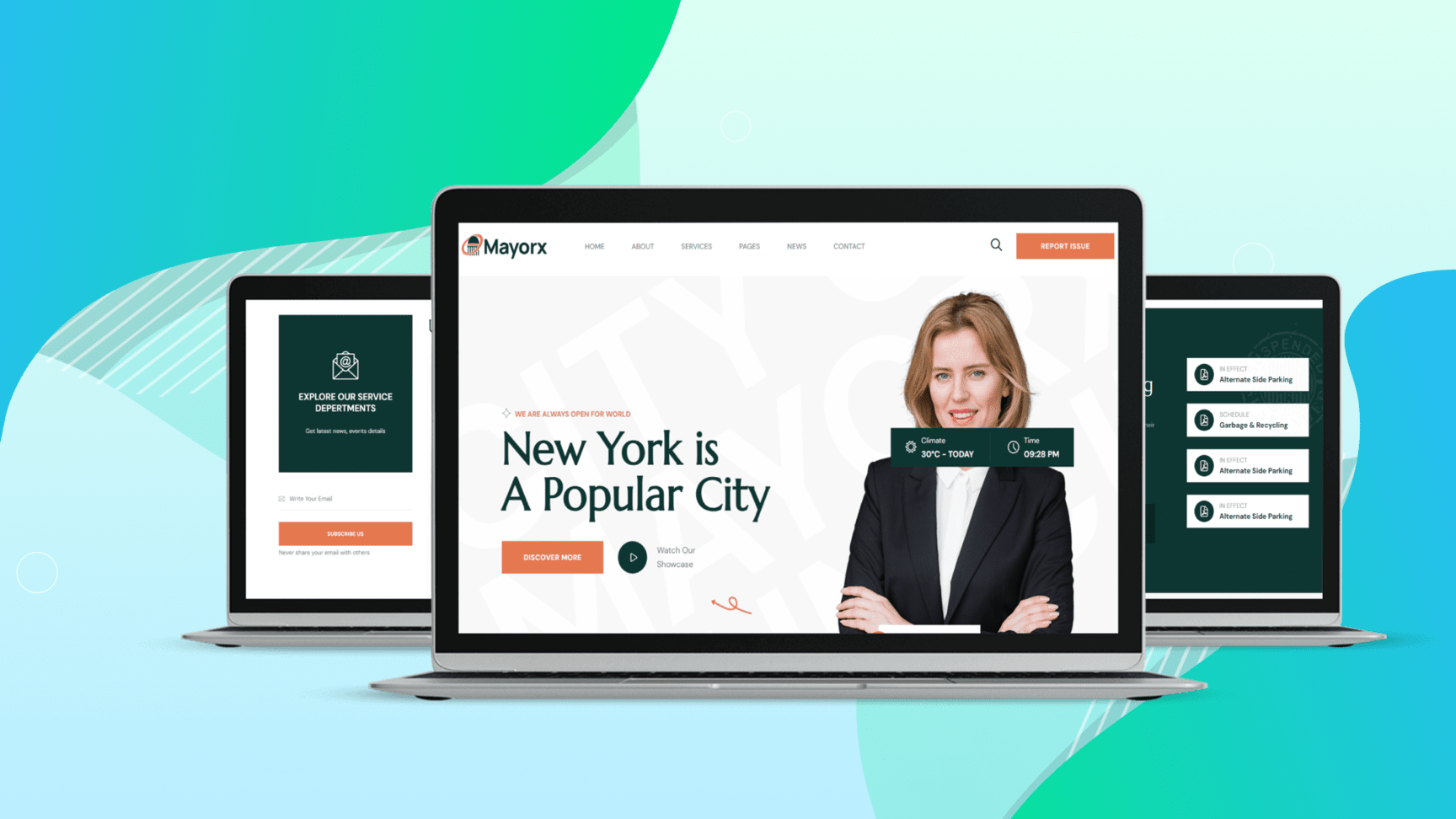
The first point of contact between citizens and their local government is often an online portal. Despite these websites’ critical role in governance and public service, many local government websites in the United States suffer. Subpar design and functionality usually plague them. This impedes access to essential services and information and discourages civic engagement and trust in governmental processes.
Effective website design is no longer just about aesthetics – it’s vital to ensuring governmental transparency, efficiency, and citizen satisfaction. Digital platforms are becoming increasingly integral to public administration. We cannot overstate the need for intuitive, accessible, responsive government websites. This article explores the current shortcomings of U.S. local government websites, underscores the expectations of today’s citizens, and discusses how specialized expertise in web design can transform these essential digital interfaces.
The Problem with Current Government Websites
Navigating the digital landscape of local government websites can often be a disorienting experience for citizens. Many websites suffer from fundamental design flaws and functional shortcomings that hinder their usability and accessibility. These issues not only frustrate users but also undermine the effectiveness of government operations online.
Poor Layout and Design
Many local government websites suffer from outdated designs that fail to meet modern web standards. This includes cluttered interfaces, confusing navigation paths, and inconsistent aesthetic elements. Collectively, these create a barrier to finding information quickly and easily. Such designs fail to accommodate the diverse needs of all citizens, particularly those with disabilities, thereby not adhering to ADA (Americans with Disabilities Act) compliance standards.
Inadequate Contact Information
One of the most critical components of a government website is the availability of clear and direct contact information. This facilitates communication between the government and its citizens. Unfortunately, it’s not uncommon to find websites where contact details are either outdated or buried under layers of navigation menus. This oversight prevents citizens from reaching out for help or reporting issues, leading to a lack of engagement and decreased trust in local governance.
Difficult Navigation and User Interfaces
The user interface (UI) is the point of interaction between the website and the user, and many government sites fail to offer an intuitive UI. This results in a steep learning curve for first-time users and inefficiency for returning users. Complex navigation structures, poor search functionalities, and slow website response times are expected, which complicate rather than simplify the process of obtaining necessary services or information.
Impact on Citizens
The culmination of these issues has tangible impacts on the community. Citizens may struggle to access critical services like emergency information, public health updates, or community notices. This lack of accessible information can lead to frustration and disengagement. Additionally, there is a pervasive sense of being underserved by their local officials. In the worst cases, it can also lead to misinformation, as people may turn to unreliable sources if they cannot find what they need on the official channels.
The Citizen’s Perspective
Understanding the citizen’s perspective is crucial in assessing the effectiveness of local government websites. In today’s digital-first world, citizens have certain expectations for how online services should function. These expectations are shaped by their daily interactions with highly efficient, user-friendly commercial websites and apps. Government websites failing to meet these standards can lead to a significant disconnect between citizens and their local governments.
Expectations of Modern Web Interfaces
Citizens expect government websites to be as intuitive and responsive as the private sector platforms they use daily. This includes straightforward navigation, fast loading times, and responsive design for access on various devices. It also features straightforward user interfaces that allow users to find information quickly without unnecessary complexity. Furthermore, they look for features that enable them to complete tasks online, such as filling out forms, scheduling appointments, and making payments, without needing to visit physical locations.

Need for Efficient Communication Channels
A primary function of government websites should be facilitating effective communication between the government and its citizens. This includes providing essential contact information and enabling real-time communication features such as chatbots, forums, and feedback modules. These tools can help bridge the gap between governments and their communities, offering a platform for ongoing dialogue and immediate problem resolution.
Importance of Feedback Mechanisms
Continuous improvement in any service-oriented sector, including government, requires essential feedback mechanisms. By incorporating easy-to-use feedback systems, local governments can gain valuable insights into citizen needs and the usability of their websites. These systems empower citizens to voice their concerns and suggestions, fostering a participatory approach to governance. This makes them feel more involved in their local communities.
The impact of a well-designed government website extends beyond mere convenience; it is a critical component in building trust and ensuring the effective delivery of services. Citizens who find their interactions with government websites positive are more likely to engage in other civic activities, reinforcing the fabric of the community. Conversely, a negative experience can lead to disillusionment and disengagement, weakening the democratic process.
Pioneers in Government Web Solutions
At Above Bits LLC, we recognize the transformative power of well-designed government websites. With decades of experience in web design and development, we have positioned ourselves as leaders. We create digital solutions that meet and exceed the expectations of government entities and their constituents. Our approach is centered around understanding the unique needs of government operations and delivering tailor-made solutions that enhance user engagement and streamline services.
Founded to elevate digital experiences, Above Bits LLC has consistently delivered innovative and effective web solutions. The company focuses on government websites across various sectors. Our team of experts combines extensive expertise in UX/UI design, digital strategy, and technical development to ensure that each project is executed flawlessly.
Expertise in Government Web Design
Government websites require a nuanced approach that balances aesthetic appeal with functionality and security. We have a proven track record of designing websites that are not only visually compelling but also highly functional and secure. We understand the regulatory and accessibility standards that government websites must adhere to, such as ADA compliance, and we ensure these criteria are met without compromising the user experience.
One of our flagship projects, supporting the ITRC website, is a prime example of our capabilities.
Comprehensive Web Solutions
Our services extend beyond mere aesthetics. We provide comprehensive web solutions that include:
- User experience design focused on the needs of diverse citizen groups.
- Backend systems that are robust and capable of handling large volumes of traffic and data securely.
- Interactive tools and communication channels that facilitate real-time interactions between governments and citizens.
Collaborative Approach
We believe in working closely with our government partners to understand their challenges and goals. This approach ensures that our solutions are aligned with each government entity’s objectives and needs.
We invite local governments to partner with us in this journey towards digital excellence. By working together, we can ensure that every citizen’s digital interaction with their government is efficient, informative, and positive. Let’s build digital platforms that meet today’s needs and anticipate tomorrow’s challenges.
Contact us today to learn how we can help you transform your government website into a digital innovation and citizen engagement model.
Frequently Asked Questions (FAQs)
Why is effective US local government website design and development important?
It allows citizens to access important information quickly and effectively. With the widespread use of the internet, people expect to be able to find the information they need quickly and easily online, and local government websites play a vital role in meeting this need.
An effective local government website design and development can improve communication and transparency between the government and its citizens. A well-designed site can provide precise and up-to-date information on local news, events, public services, and resources. This can increase citizen engagement and participation in local governance and improve trust in government.
How can a well-designed local government website increase citizen participation?
A well-designed site can give citizens easy access to information about government programs and services. This makes it easier for them to participate in the democratic process. For example, a website that allows citizens to pay bills, file complaints, and submit requests online can increase participation and engagement.
What are some best practices for designing an accessible local government website?
To design an accessible website, you should ensure it is compatible with assistive technologies. This includes screen readers and other accessibility tools. You should also provide alternative text for images and videos, use clear and concise language, and ensure the website is easy to navigate.
